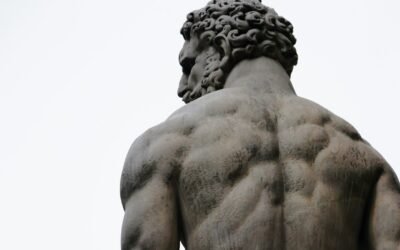In our last article in this series, we considered how the image of God informs our creativity as Christians and how sin has marred that image – corrupting our vision and desires. In this article, we will continue to explore the effects of sin on our creativity.
Romans 1 | Our Trifold Exchange
The fact that Divine beauty not only displays God’s glory but also demands a response is taken up by Paul in Romans 1, where the effects of sin on humanity are said to have corrupted this proper response. This response which God’s glory demands is the whole basis why Paul says that people in their sin are without an excuse – because God’s glory in creation has been made plain to them and they should respond with worship to Him, but they don’t.
“For what can be known about God is plain to them, because God has shown it to them. For his invisible attributes, namely, his eternal power and divine nature, have been clearly perceived, ever since the creation of the world, in the things that have been made. So they are without excuse.” (Romans 1:19-20)
Instead, there are 3 exchanges which happen that correspond to the 3 aspects of God’s Triadic glory in our previous article:
- Verse 25 – exchange the truth for a lie (telling | truth | content)
- Verse 23 – exchange God’s glory for images (showing | aesthetics | form)
- Verse 26 – exchange natural sexual relations for unnatural (doing | power | purpose)
Creative Idolatry
Our creativity was always meant to be oriented God-ward. In our sin, we exchange this for futility. Here is an example of what that exchange can look like for creatives…
Enslaved to Creativity’s Production
Thomas Terry and Ryan Lister note:
“We’ve exchanged a philosophy of creativity for the pragmatism of productivity. The contemporary catchphrase “Never Stop Creating” offers little space to consider where our creativity originates. Our contemporary fascination with creativity’s production keeps us so busy that we don’t pursue creativity’s original purpose. This is creativity’s contemporary mission drift: we are concerned primarily with how we are going to fill the shelves rather than why we want to fill them at all. While our portfolios may be full, we will find it tough to explain beyond subjective or pragmatic platitudes-why our portfolio exists in the first place.” (Images & Idols, 24)
Many creatives – especially in social media fields, find themselves enslaved to the pressure to always be creating something new.
The likes, retweets, re-shares and viral marketing become our merciless taskmasters and the shackles our egos are chained to because we’ve found our identity and worth in the approval our creativity brings us from others.
A Functional Saviour
David Covington notes:
“The Romantic Movement elevated beauty aesthetics-over truth and goodness in order to rescue humanity from the dehumanizing rationalism of the Enlightenment. The Industrial Revolution followed power and productivity at the cost of beauty and truth; “form follows function.” Each sounded like a good idea at the time, and none alone can deliver the goods.” (A Redemptive Theology of Art, 124)
Again, Terry and Lister are helpful, commenting that:
“Idolatry is the prideful act of adding imagination to our rebellion in order to create something to take God’s place in our lives. Creativity and idolatry come as a package deal. Idolatry is what happens when image bearers become image makers with creation’s images. It’s why creativity so quickly became idolatry handmaiden after the fall. In the chaos of cosmic treason, those made in the likeness of God fashion replacement gods in their own shattered likeness through their own misplaced creativity…” (Images & Idols, 75)

If we do not start with God and a God-centered definition of beauty and creativity, then every cultural moment in history has tended towards imbalance. Emphasizing one aspect of the Glory Triad over another. Without God as the proper target of our creative compass – we elevate aesthetics, or productivity, or rationalism as our ‘functional saviours’ – the things which will really set things right. As C.S. Lewis noted, “There is but one good; that is God. Everything else is good when it looks to Him and bad when it turns from him.”
Your creativity – wrongly aimed – will lead you into idolatry.
“Art for Art’s Sake” – Autonomous Artists
While artists and creatives are susceptible to the full spectrum of sins, it would be my estimation that the sin of pride lurks at our door most frequently. Our sinfulness makes us mix up representing God (imaging God) with replacing God with our artistic endeavors. This is what the 2nd Commandment against idolatry forbids – replacing God with something of our own creation.
Our secular culture, as it abandoned any reference to God, needed something to aim its creativity. And so, the artist themselves or the art itself became that reference point. This was heavily reflected in the development of postmodern art. “Art for Art’s sake” became the championed slogan of newly ‘liberated’ creatives who no longer felt bound to a Creator but became self-made creators.
“Almost overnight, creatives became the world’s “genius… with very special gifts (who could give mankind something of almost religious importance in. the work of art.” That is why creatives and artists today don’t simply reflect or serve the culture they determine it. They fill the world’s spotlight and hold the world’s microphone. They stand before the world-as clichéd as it has become-as the culture’s prophets and, perhaps even to a greater extent, as the gods we can catch a glimpse of in the mirror. “Art for Art’s Sake” turned creativity into its own cult and the creative into the culture’s high priest and demigod. In making new idols for the world, creatives have been made new idols by the world… Self-determination is always the seedbed of idolatry…” (Images & Idols, 72)

The truth about “Art for Art’s sake” though is that it is never just for ‘art’s sake’ but there is always some worldview behind it. If it is not the Christian one, then some other philosophy will motivate and drive your art.
Your art and creative calling will not save you
Vincent Van Gogh felt called to pursue painting to communicate deeper spiritual truths. However, he made his art and other things the center-point of his life’s meaning. Throughout his life he was a troubled soul. In his quest to create his own meaning and purpose through his art, he grew despondent and eventually took his own life when he failed to realize the lofty goal of salvation through his art.
Even for Christian artist, the temptation is real – God’s beauty can turn into a stepping-stone on their climb to fame.
“The idol of creativity captures our attention with our own reflection and holds it there until all we can see is ourselves and our imaginative “genius.”…We reduce everyone to a retweet or a like in our social media feed. Creatives sit on thrones of their own making, while their followers cast their time and money at their feet. Over time, though, creatives trade artistic purity for its fringe benefits. As a result, their followers eventually become their leaders; the assumed needs of the audience overtake the creative’s initial love.” (Images & Idols, 86)

However, neither you, nor your followers and likes, nor your admirers can hold up the weight of your soul’s needs for acceptance, redemption, and satisfaction. They will all, in the end, break your soul. You will end up not knowing why you create. At best, your creativity will become self-serving – idolatrous and prideful – but you will feel more empty and alone. This is because when we lose God as our reference point, we stop creating for Him, and even stop creating for ourselves even! We create to keep up appearances, appease critics, to put on a facade, and keep the money and fame machine rolling.
As idolaters, we are doing one of two things: we either make a god with our imaginations or make ourselves gods with our imaginations. Both of these will break our souls.
This concludes our second section of our Gospel-shaped theology of creativity. We’ve seen that sin has corrupted our vision and desires so that we no longer image God properly in worship to Him. We also saw how our sinful exchange of God’s glory for created things leads to using our creativity in idolatrous ways and becoming autonomous artists in our pride.
In our next article, we’ll take a look at how Christ redeems our creativity. I hope you’re enjoying this series! The next article comes out next week Thursday. Subscribe and follow to stay up to date on all new content, and please consider liking, commenting and sharing if you find it helpful or interesting.
Articles in this series:



